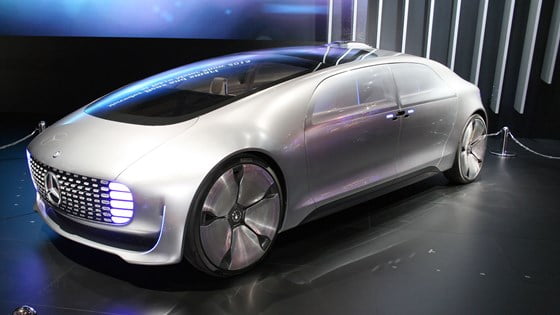The new Vision Tokyo looks oddly familiar somehow?
You might be thinking of the F 015 Luxury in Motionconcept, a self-driving limo with a private lounge interior revealed at the Consumer Electronics Show in Las Vegas earlier this year. The Vision Tokyo is cut from the same futuristic cloth, but while the Luxury in Motion sat four occupants in individual swivelling armchairs, the taller Vision Tokyo is designed to seat five occupants along a wraparound sofa arrangement. It’s MPV meets DFS.
I take it this is a self-driving concept?
Yes, although it can theoretically switch from autonomous to manual driving modes. A front-facing seat can slide out of the sofa, and the steering wheel moves into place from its ‘standby’ position. The sofa set-up’s designed so that occupants can chat face to face, while the Vision steers its own course through downtown Tokyo gridlock.
A concept car that embraces current-era buzzwords wholeheartedly, not only is the Vision Tokyo autonomous, it’s connected too. Apps, maps and social media displays appear as 3D holograms in the centre of the interior. Don’t expect to see that particular feature as an option on a fleet-spec C-class just yet.
Mercedes Vision Tokyo: design
In terms of size, the 4.8m-long, 1.6m-high concept is similar in length to an E-class saloon and in height to a B-class (hold that thought). The interior’s accessed via a single, upward-swinging door on the left-hand side (as the name suggests, the Vision Tokyo’s been designed with the roads of Japan’s cities in mind).
On the outside, the narrow headlights are based on those of the AMG Vision Gran Turismo concept, the wheels are a giant 26 inches in diameter, and in-built LED modules can turn the car into a kind of giant mobile light show.
Does it work?
This is a theoretical design study rather than a serious engineering project, but the Vision’s designed with an electric powertrain in mind, using both hydrogen fuel cells and a high-voltage, induction-charged battery. Mercedes envisages a total range of around 610 miles.
 Who is it for?
Who is it for?
Generation Z (or people born since 1995 in other words), apparently, particularly those living in megacities like Tokyo.
‘The role of the vehicle has changed for this global generation: it is no longer simply a means of getting around, but a digital, automobile companion,’ says Mercedes. ‘With each journey, [the Vision Tokyo concept] becomes more and more familiar with its occupants, their likes and preferences. All of which makes the Vision Tokyo the perfect partner for Generation Z.’
[“source-carmagazine”]




 Who is it for?
Who is it for?